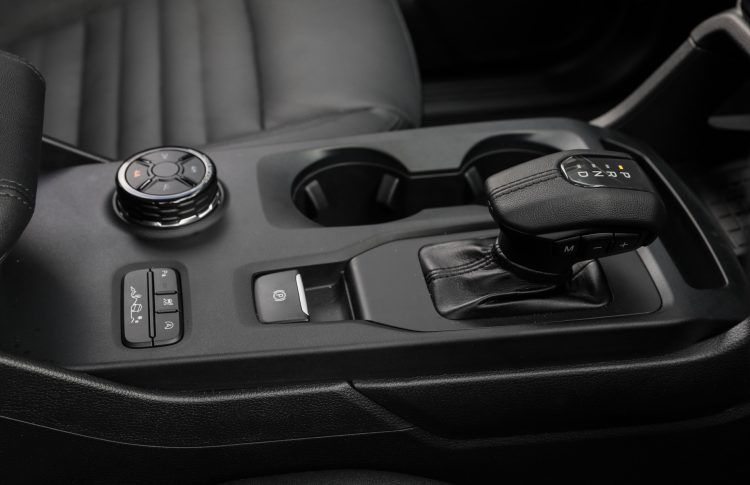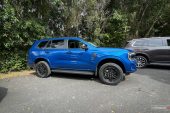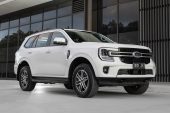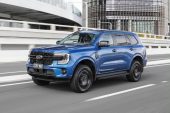This is it, the seven-seat SUV sibling of the exciting new Ford Ranger; the (mostly) all-new 2023 Ford Everest. It comes into the heavy-duty SUV field as a more refined and more intelligent proposition than ever before, which should leave many competitors shaking in their boots.
Four variants make up the lineup, spanning from the Ambiente, Trend, Sport and flagship Platinum. Both entry grades are available in 4×2 form – without four-wheel drive that is – while the rest feature a part-time rear-/four-wheel drive system with on-the-go control. We had a chance to test drive most variants during the official media launch event in Queensland recently, however, our 0-100km/h testing and video below is based on the Sport V6.
The new model shares the same Australian-developed T6 platform as before albeit in heavily-revised form, and there’s a 3.0-litre turbo-diesel V6 joining the range for the first time. Although, it is only accessible in the upper two trim levels. Prices start from $52,990 for the base Ambiente 4×2 and top out at $77,690 for the Platinum V6 4×4 (excluding on-road costs).
2023 Ford Everest Sport – THE SPECS
Engine: 3.0-litre turbo-diesel V6
Output: 184kW@3250rpm / 600Nm@1750-2250rpm
Transmission: 10-speed auto
Drive type: Part-time four-wheel drive, locking rear diff
0-100km/h (PD tested): 8.40
Tare weight: 2335kg
Official fuel economy: 8.5L/100km
Starting price: $69,090
2023 Ford Everest – THE PACKAGE
The new-look design is superb in our opinion. It looks strong and muscular, but also refined and modern. The attention to detail has been enhanced over the previous model, with more intricate lighting and trimmings, and further distinction between each trim level. For example, the Platinum presents unique badges including a special enclosed showcase between the taillights, while the Sport variant adds a range of fashionable black highlights for that sporty look.
Most models during the event were fitted with the optional Goodyear Wrangler all-terrain tyres, measuring 255/65, mounted on 18-inch alloy wheels. Aside from the flagship Platinum model, which rides on impressive new 21-inch alloy wheels wrapped in fairly low profile 275/45 tyres. This is obviously not the best option for those looking to venture deep into the wilderness, but for everyone else planning on using the Everest predominately on the road, the big wheels add a new level bling to the otherwise rugged model line.
The interior is a big leap forward too in terms of practicality and technology. Up on the dash is a huge vertical touch-screen which comes in either 10- or 12-inch size, depending on the grade, and it has purposely been designed to sit within the dash theme rather than stuck on it. Most of the interior is quite vertical and appears as a solid structure, but this theme also opens up space or at least the perception of.
The centre console is very ergonomic and offers plenty of storage, with all variants coming standard with a padded wireless phone charger. All models also come with wireless Android Auto and Apple CarPlay, which is a real bonus in today’s market as some premium marque’s don’t even offer wireless connectivity, or charge extra for the privilege.
Down on the console you might also notice the new e-shifter. What’s that? You ask. Basically, it looks like a proper, mechanically-connected gear selector but in reality it is a clever, fully electric shifter. Say you open the door and intend to get out but you accidentally leave it in Drive. The shifter can automatically move back up into the Park position, like magic. The shifter also looks sleek and helps to free up space. It comes standard on all 4×4 models.
Passenger comfort and space is plentiful, including in the second row which slides on rails and offers recline adjustment. Space in the third row has increased thanks to the squarer roofline that extends further back than before, and Ford says it has applied various revisions to this area to help make it more accommodating not only for kids but adults as well. Rear climate control is available from the second row, with vents in the ceiling for all three rows. There’s also charging ports and even heated rear seats available.
Boot space is increased over the previous model by around 10 to 20 litres, depending on the seating configuration applied. The Platinum model showcases fully electric third-row seats, which certainly make life easier if you’re juggling shopping and kids. Some under-floor storage is provided and fully sealed, so it is perfect for wet or dirty gear.
A flip-up divider comes with little support struts too, so you can restrict smaller items from rolling around in the back. A full-size spare wheel sits under the back, outside, with a 17-inch steel rim for the Ambiente and full-size alloys for all others.
2023 Ford Everest – THE DRIVE
Underneath you’ll find a live axle rear end, as before, with coil springs at the back compared with the more heavy-duty leaf springs on the Ranger. At the front is an independent setup with coil springs. Ride comfort is quite good, especially against the Ranger; this is designed to be a much more family-friendly unit, so that’s a given. We notice some tyre roar with the optional A/T tyres, but it’s totally tolerable. We guess our best advice is make sure you actually use the chunky tyres if you go to the length of optioning up to them in the first place. Otherwise, the standard items will perform just fine even in reasonably serious off-road scenarios, and you’ll experience a hush on-road cruise.
On-road poise and stability feels significantly improved over the previous model. The front end remains flat and solid during cornering, with what feels like less body lean than before. The steering is still rather bland albeit quite responsive for this style of vehicle; you don’t need to dial in miles and miles of lock just to change lanes, in other words. You can push hard in the bends and the tyres don’t immediately moan in protest, but obviously this is primarily a heavy-duty SUV, so some soft-roaders are more suitable if you’re only planning tarmac-based journeys.
Rear end stability is a bit less refined due to the live axle arrangement. But it is held together via a comprehensive Watt’s link setup, invented in 1784, which is essentially a double Panhard rod that restricts lateral movement under suspension compression. With the heavy-duty live axle setup comes impressive towing and payload capacities. The new Everest is now rated at a maximum of 3500kg for braked trailers, scaring away many of its competitors. Depending on the variant, payload capacities range from 741kg for the base (lightest weight) Ambiente and down to 658kg for the Platinum.
More importantly, the gross combination mass is 6250kg across the board. So that means for the the Sport variant, for example, which has a kerb weight of 2454kg, you’ll have 296kg leftover for passengers and cargo after hitching up a 3500kg trailer. It’s not much but it is more than what many competitors offer. For reference, the Isuzu MU-X LS-U has 245kg leftover after hooking up a 3500kg trailer, with its 5900kg GCM. The Toyota Prado VX has a maximum towing rating of 3000kg, as with the Mitsubishi Pajero Sport GLS (comparing upper-mid spec rivals to the Everest Sport as an example).
The new V6 turbo-diesel is a perfect fit for the Everest in our opinion. It’s really smooth and effortless, making it an ideal option for big road trips around the country. We haven’t tested it with a trailer or caravan, but we’d be guessing the advantages of the V6 over the old 2.0-litre bi-turbo four-cylinder would be clear. We can hear the V6 is noticeably quieter than the 2.0L as well.
With more cylinders it means more compression for engine braking, and the V6’s 600Nm of torque would obviously assist in getting the rig up to speed. Speaking of which, during the event we ducked away to a quiet backroad to run some performance tests – we will be conducting our usual, more comprehensive performance tests in the near future. As a first impressions, we clocked 0-100km/h in a best of 8.40 seconds, according to our Racelogic Vbox Sport.
We had the opportunity to test the new machine on a range of off-road tracks, including up and down steep climbs, and through relatively deep mud ruts. With the optional off-road tyres in particular, the Everest had no trouble tackling everything we threw at it. The side steps are mounted pretty high so they don’t instantly snag protrusions the moment you go off road. And the suspension travel seems to provide good flex to keep the wheels firmly planted for optimum traction. A rear diff lock on most models also provides additional assurance.
A water wading depth of 800mm is probably going to be more than enough for the average punter, although, we’re not sure about the positioning of the engine intake, which is right at the front, above the grille. You can option for official ARB snorkels and so on if you want to, right from the dealership. Such accessories are covered by Ford’s warranty, too, for absolute peace of mind. We hear the parts are slightly more expensive through Ford compared with heading into an ARB retailer. But again, you’re also paying for the inclusion of Ford’s five-year warranty.
2023 Ford Everest – THE VIDEO
2023 Ford Everest – THE VERDICT
The Everest remains as one of the most heavy-duty seven-seat SUVs on the market, but now it’s also one of the most practical and most refined. The new in-car connectivity and technology really pushes it into new territory and nudges the benchmark further forward, ahead of most rivals. And with the V6 option in the mix, it should be even better for towing while providing effortless highway cruising. It’s now time for the rivals to play catch-up.










































